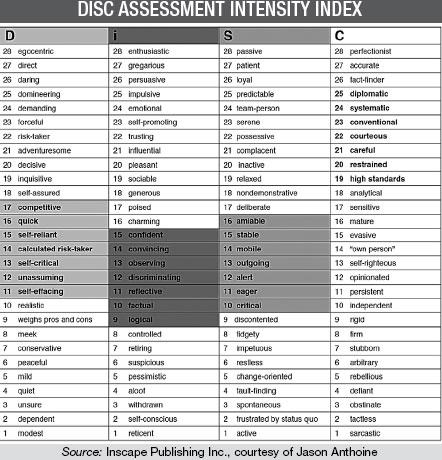Gone are the days of cafeteria warfare, where the decision of where to sit and with whom defined you in the social hierarchy--or so you thought. True, playground initiations
(and, now, MySpace popularity contests) are the things of child's play, but they have also elbowed their way into the workplace, evolving from schoolyard cliques to office
politics just as teenagers grew (dare we say matured?) into professionals.
However, the inevitability of personality clashes among employees has negative repercussions on morale, not to mention productivity. These challenges transcend internal
communications to impact agency-client relations as well. As a communications manager whose success largely depends on building strong relationships with multiple constituents,
you would be wise to start with those among employees. Team-building exercises exist to:
-
Give senior executives insight into the best ways to manage employees based on individual personality characteristics;
-
Allow employees to understand their own strengths and weaknesses, as well as those of their co-workers, which can make serious inroads in alleviating personality conflicts;
and,
-
Anticipate potential conflicts between agency execs and clients so that the best possible account managers can interface with employees on the client side.
Here are some exercises to consider when the goal is promoting teamwork and understanding among employees and managers:
*Personality Assessments: "Especially for communications departments, one of
the most effective things as far as building teams and making things cohesive
is a DISC (dominance, influence, steadiness, conscientiousness) assessment,"
says Jason Anthoine, head of Cohesion Group. "It's a psychological profile based
on 28 sets of words where you choose the ones that best describe you--for example,
outgoing, introspective, driven or vacillating." (Note: There are many psychological
profiling exercises to choose from; Anthoine cites DISC as the one he has experience
with. For a sample DISC summary with a list of traits and characteristics, see
table.)

The key to this exercise is having employees choose words based on what best describes them, not on how they want to be described. There are no wrong answers, of course, and
the results produce an extensive personality assessment that specifies each individual's work habits, creativity patterns, persuasiveness, etc. While these insights are key for
personal growth, the act of completing the assessment and discussing the results as a group is the crux of the team-building exercise. Openness is key.
"This exercise will help you understand what type of style people are, and how to work with them in relation to your own. It gives everyone insights into how they can interact
with each other in ways that both sides get what they want from the engagement," Anthoine says. "You want to be as open as possible because the point is for everyone to know each
other's work styles. Then, everyone is aware and can adjust accordingly."
Anthoine also cites the value of conducting these assessments at the onset of an agency-client relationship to see if there is a natural chemistry, and to help match clients
with the internal employees that best complement work styles.
*Social Networks: During a panel at last week's CMO Leadership Forum, Andy Berndt, managing director of Google's Creative Lab, told the audience about an exercise he launched
while he was at Ogilvy & Mather New York.
"At Ogilvy, we had this forced training with [senior executives] where we sat them down and made them create a MySpace page," he says.
This activity was initiated to force managers to work with digital media--something to which they were openly resistant--but it precipitated the conversation about one
organization that required its employees worldwide to create a Facebook profile. True, it prompted a deluge of e-mails to the initiator from around the world (in every language
imaginable, to boot), but it got employees to engage with one another on a casual, personal level. Employees who had never met began linking to their peers' pages, posting
messages and sharing content. You'd be surprise by the bonding that can occur over shared taste in music or film.
*Video Games: Marie Antoinette famously (and controversially) said "Let them eat cake" in response to the revolt surrounding her declining popularity. The modern day version of
that statement should be "Let them play games"--at least as far as managers are concerned. Many organizations, including Philips Electronics, have created a video game concept
around the needs of their organization, especially to enhance management communications and teamwork among employees.
"We are always looking for ways to reach employees in creative ways," says Silvia Avella, communications project manager of Philips Electronics North America. "When we found a
need to get managers to communicate with employees, and to get employees to rely on teamwork to drive business forward, we presented a business case [to senior management] for
building a video game to solve the issues at hand."
Consider video gaming to be the 2.0 version of the rope courses and trust falls that were popular team-building exercises in the 1990s. (For more on Philips' video gaming
initiative, see "Will the Real Mario Bros Please Stand Up? Video Gaming Tech Rocks PR's World," PRN 07-02-07.) PRN
CONTACTS:
Jason Anthoine, [email protected]; Silvia Avella, [email protected]
Best Practices in Team Building
When launching any team-building initiative, Jason Anthoine, head of workplace communications firm Cohesion Group, recommends the following tips for getting everyone to play
nice:
-
Focus on trust: "Anything you can do to bring the team together that doesn't have to do with work is a way to build trust," Anthoine says. "That's the goal of all
exercises. Without trust, there is nothing to build a team around."
-
Make top managers the center of the effort: "The biggest trust gap is between the senior leaders and the front-line employees of an organization. If team-building isn't
driven by the highest levels of the organization, you are just doing a flavor-of-the-month, and employees will see right through that.
-
Sincerity is essential: This speaks for itself.
